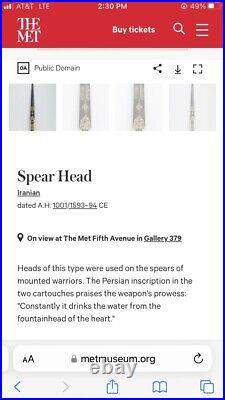Antique Indo Persian Wootz Lance Head. Furusiyya Spear. Islamic, no sword tulwar












Rare Antique Indo Persian Lance Head. Here we offer a very rare example of an antique Persian (or Persian / Mughal influenced) lance head. This example is extremely sturdy (due to blade thickness and slight Diamond cross section profile, and central raised rib along centerline of blade). Very pointed no sharp tip. I believe the lateral edges were sharpened at one point.
Most likely a cavalry lance, or even (due to exotic gold damascene floral designs), a palace guard lance. This is not a run of the mill lance head.
Other later Qajar dynasty prototypes are far less sturdy and yield thinner (more decorative in function) blades. This lance was for battle! It is possible due to the overall quality that this spear is made of wootz, but as yet I have not tested it with etching acid. The iron ball section, between collar and blade is very solid, and does not appear hollow. At the least it could act as a mini-mace in function.I cannot find another example exactly like this one, but there is one somewhat similar in the Met museum, albeit with far better goldwork on theirs, that dates from the 1700's. My instinct tells me that this is of similar age.
1600's to late 1700's. Katar dagger, Persian, coffee, pot, tray, and cup, not included, reference only.Please note the lance in Stone's book of another similar Persian lance. Thank you for your business. Key words, Arabic, Indian, Shastar, katar, tulwar, damascus, polearm, halberd, cavalry, HEMA, armes, pulwar, tegha, tabar, tabarzin, armor, armour, helmet, Syrian, Mamluk, ottoman, Turkish, dagger, decor, knight, javelin, shield, dhal, sipar, martial art, Yari. This item is in the category "Antiques\Asian Antiques\Middle East".
The seller is "worldlinkagent3" and is located in this country: US. This item can be shipped worldwide.
- Primary Material: Iron
- Type: Spear Head
- Color: Multi-Color
- Original/Reproduction: Antique Original
- Region of Origin: Middle East
- Age: Pre-1800
